PUBH6006: Community Health & Disease Prevention: Diabetes Prevention
VerifiedAdded on 2023/06/03
|11
|2840
|75
Essay
AI Summary
This essay discusses community health and disease prevention, focusing on mobilizing and empowering communities to prevent type 2 diabetes. It applies Laverack’s ladder of community-based interaction and Liberato et al's core domains of capacity-building to propose methods for community mobilization in preventing type 2 diabetes, including engaging communities in planting healthy food, fostering economic readiness, and using community opinion leaders. The essay also highlights the importance of socio-environmental conditions, active partnerships, and addressing community needs. Furthermore, it emphasizes the use of educational programs and social learning theory to promote healthier practices and prevent type 2 diabetes, considering the complexities of health behavior change and the chronic nature of the disease.
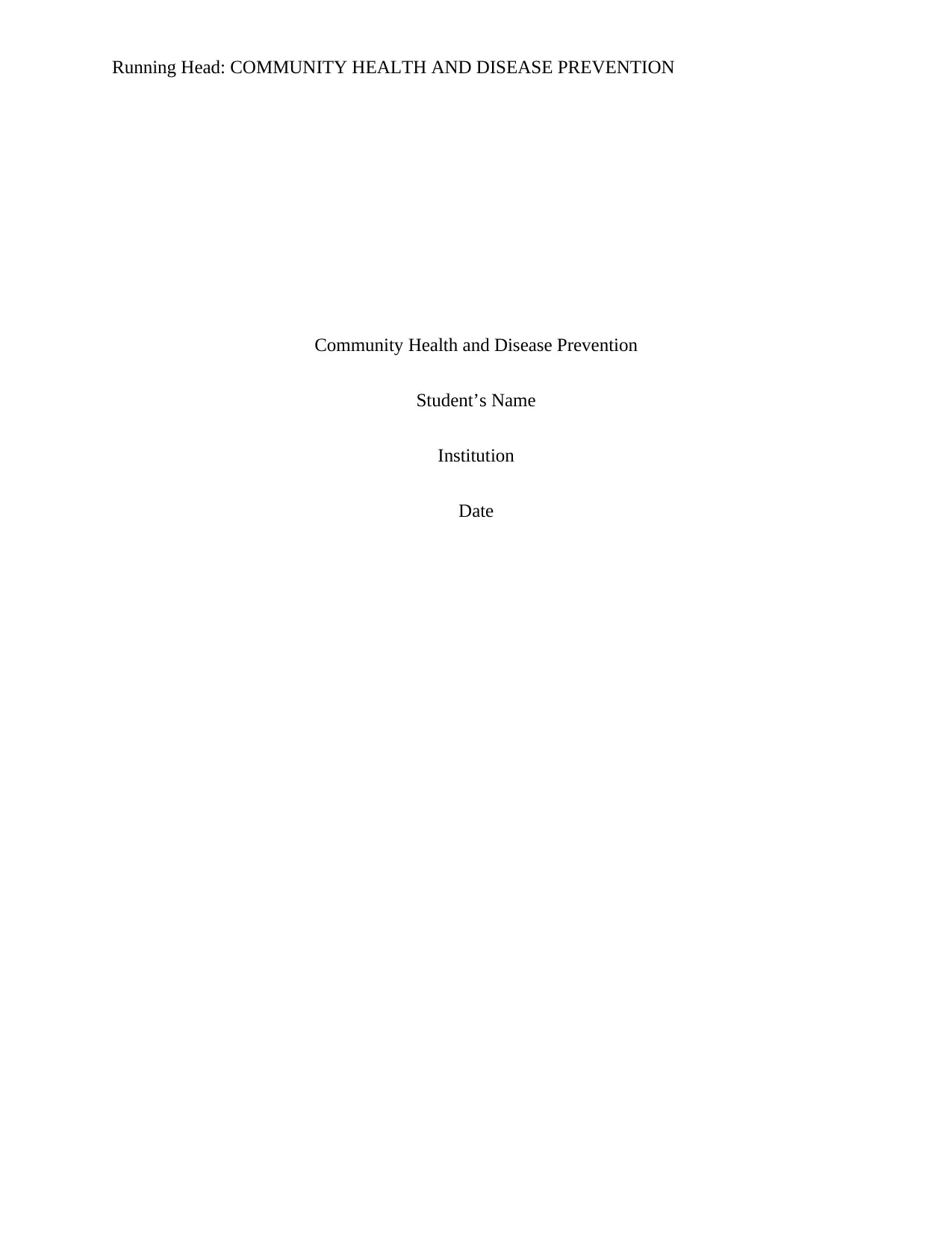
Running Head: COMMUNITY HEALTH AND DISEASE PREVENTION
Community Health and Disease Prevention
Student’s Name
Institution
Date
Community Health and Disease Prevention
Student’s Name
Institution
Date
Paraphrase This Document
Need a fresh take? Get an instant paraphrase of this document with our AI Paraphraser
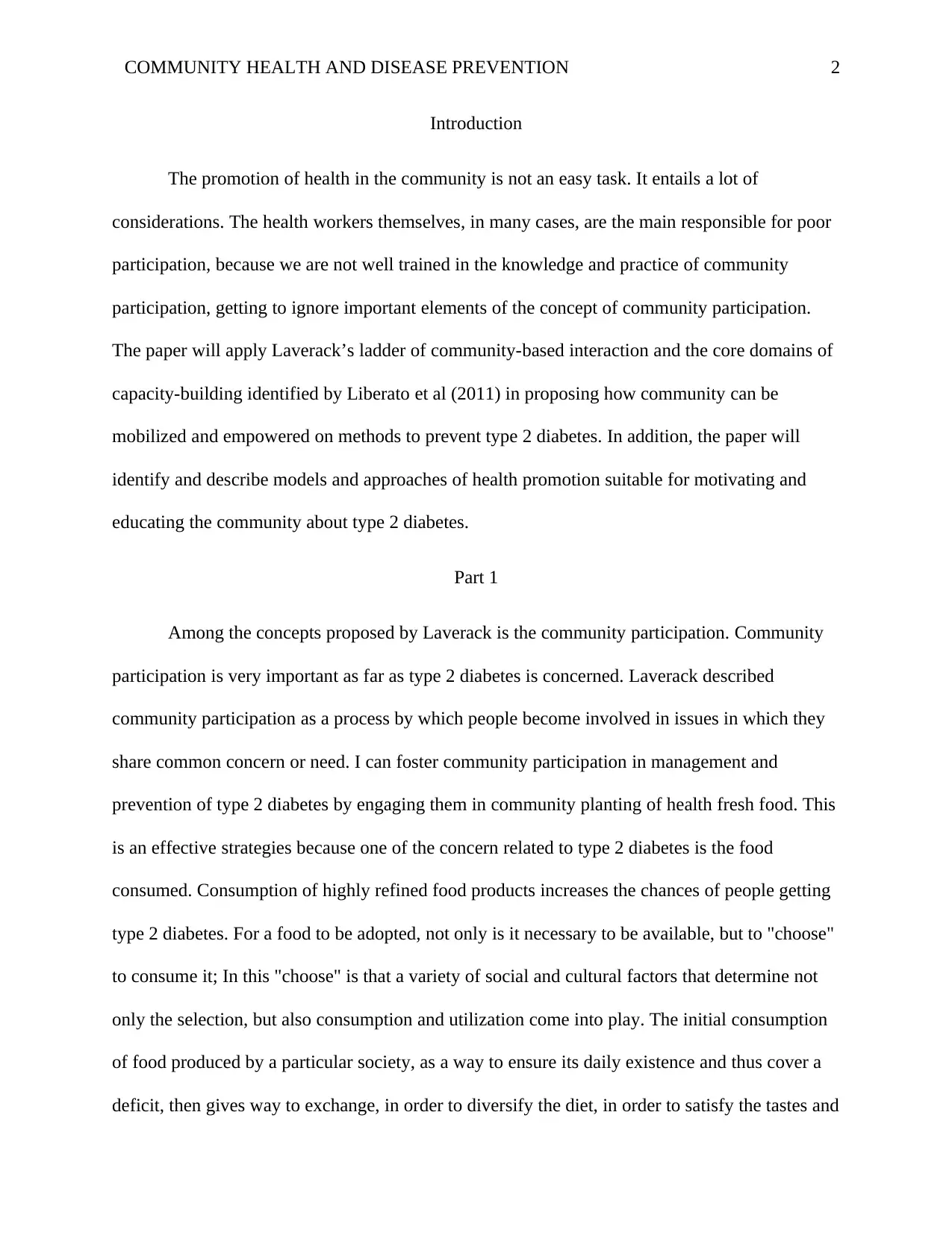
COMMUNITY HEALTH AND DISEASE PREVENTION 2
Introduction
The promotion of health in the community is not an easy task. It entails a lot of
considerations. The health workers themselves, in many cases, are the main responsible for poor
participation, because we are not well trained in the knowledge and practice of community
participation, getting to ignore important elements of the concept of community participation.
The paper will apply Laverack’s ladder of community-based interaction and the core domains of
capacity-building identified by Liberato et al (2011) in proposing how community can be
mobilized and empowered on methods to prevent type 2 diabetes. In addition, the paper will
identify and describe models and approaches of health promotion suitable for motivating and
educating the community about type 2 diabetes.
Part 1
Among the concepts proposed by Laverack is the community participation. Community
participation is very important as far as type 2 diabetes is concerned. Laverack described
community participation as a process by which people become involved in issues in which they
share common concern or need. I can foster community participation in management and
prevention of type 2 diabetes by engaging them in community planting of health fresh food. This
is an effective strategies because one of the concern related to type 2 diabetes is the food
consumed. Consumption of highly refined food products increases the chances of people getting
type 2 diabetes. For a food to be adopted, not only is it necessary to be available, but to "choose"
to consume it; In this "choose" is that a variety of social and cultural factors that determine not
only the selection, but also consumption and utilization come into play. The initial consumption
of food produced by a particular society, as a way to ensure its daily existence and thus cover a
deficit, then gives way to exchange, in order to diversify the diet, in order to satisfy the tastes and
Introduction
The promotion of health in the community is not an easy task. It entails a lot of
considerations. The health workers themselves, in many cases, are the main responsible for poor
participation, because we are not well trained in the knowledge and practice of community
participation, getting to ignore important elements of the concept of community participation.
The paper will apply Laverack’s ladder of community-based interaction and the core domains of
capacity-building identified by Liberato et al (2011) in proposing how community can be
mobilized and empowered on methods to prevent type 2 diabetes. In addition, the paper will
identify and describe models and approaches of health promotion suitable for motivating and
educating the community about type 2 diabetes.
Part 1
Among the concepts proposed by Laverack is the community participation. Community
participation is very important as far as type 2 diabetes is concerned. Laverack described
community participation as a process by which people become involved in issues in which they
share common concern or need. I can foster community participation in management and
prevention of type 2 diabetes by engaging them in community planting of health fresh food. This
is an effective strategies because one of the concern related to type 2 diabetes is the food
consumed. Consumption of highly refined food products increases the chances of people getting
type 2 diabetes. For a food to be adopted, not only is it necessary to be available, but to "choose"
to consume it; In this "choose" is that a variety of social and cultural factors that determine not
only the selection, but also consumption and utilization come into play. The initial consumption
of food produced by a particular society, as a way to ensure its daily existence and thus cover a
deficit, then gives way to exchange, in order to diversify the diet, in order to satisfy the tastes and
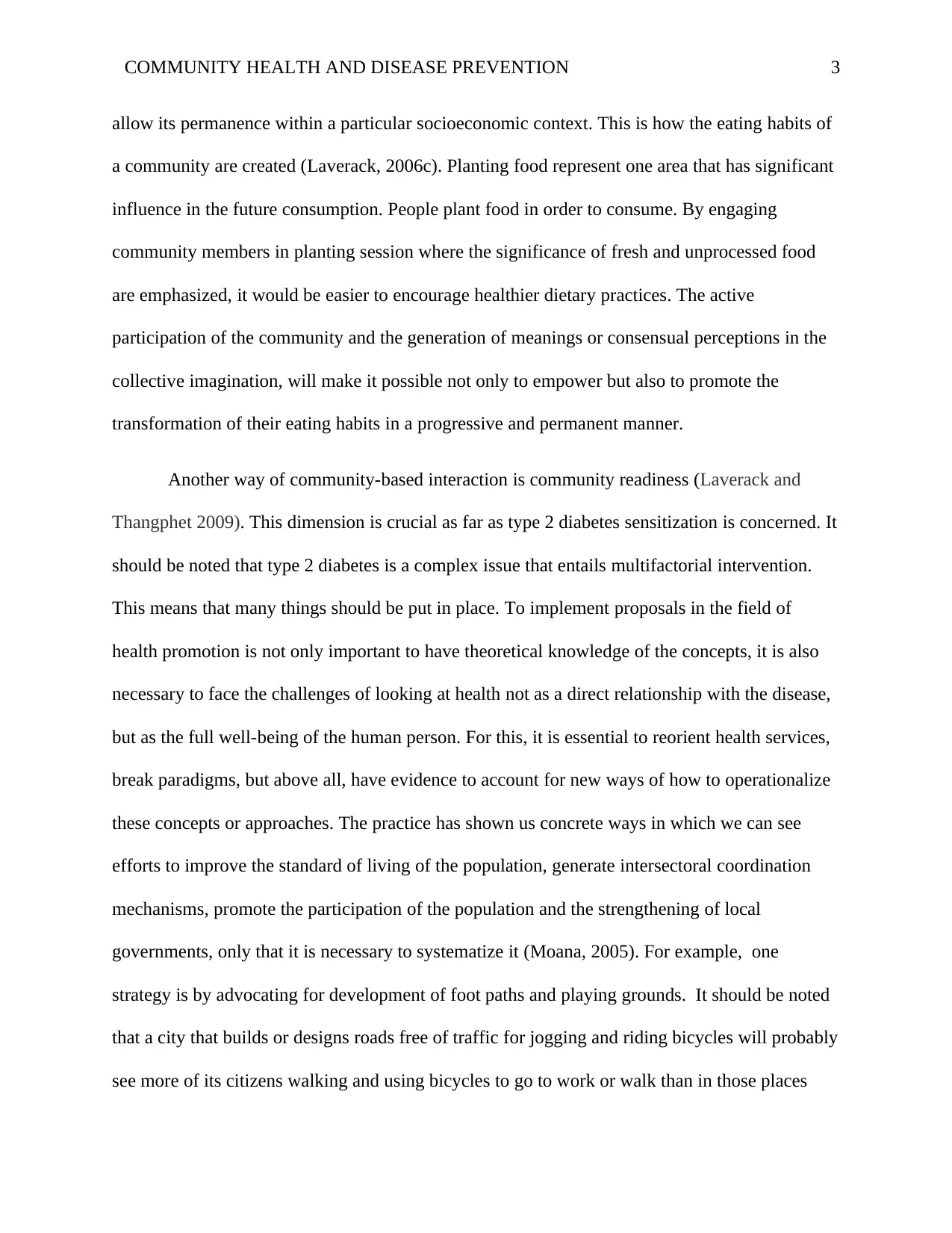
COMMUNITY HEALTH AND DISEASE PREVENTION 3
allow its permanence within a particular socioeconomic context. This is how the eating habits of
a community are created (Laverack, 2006c). Planting food represent one area that has significant
influence in the future consumption. People plant food in order to consume. By engaging
community members in planting session where the significance of fresh and unprocessed food
are emphasized, it would be easier to encourage healthier dietary practices. The active
participation of the community and the generation of meanings or consensual perceptions in the
collective imagination, will make it possible not only to empower but also to promote the
transformation of their eating habits in a progressive and permanent manner.
Another way of community-based interaction is community readiness (Laverack and
Thangphet 2009). This dimension is crucial as far as type 2 diabetes sensitization is concerned. It
should be noted that type 2 diabetes is a complex issue that entails multifactorial intervention.
This means that many things should be put in place. To implement proposals in the field of
health promotion is not only important to have theoretical knowledge of the concepts, it is also
necessary to face the challenges of looking at health not as a direct relationship with the disease,
but as the full well-being of the human person. For this, it is essential to reorient health services,
break paradigms, but above all, have evidence to account for new ways of how to operationalize
these concepts or approaches. The practice has shown us concrete ways in which we can see
efforts to improve the standard of living of the population, generate intersectoral coordination
mechanisms, promote the participation of the population and the strengthening of local
governments, only that it is necessary to systematize it (Moana, 2005). For example, one
strategy is by advocating for development of foot paths and playing grounds. It should be noted
that a city that builds or designs roads free of traffic for jogging and riding bicycles will probably
see more of its citizens walking and using bicycles to go to work or walk than in those places
allow its permanence within a particular socioeconomic context. This is how the eating habits of
a community are created (Laverack, 2006c). Planting food represent one area that has significant
influence in the future consumption. People plant food in order to consume. By engaging
community members in planting session where the significance of fresh and unprocessed food
are emphasized, it would be easier to encourage healthier dietary practices. The active
participation of the community and the generation of meanings or consensual perceptions in the
collective imagination, will make it possible not only to empower but also to promote the
transformation of their eating habits in a progressive and permanent manner.
Another way of community-based interaction is community readiness (Laverack and
Thangphet 2009). This dimension is crucial as far as type 2 diabetes sensitization is concerned. It
should be noted that type 2 diabetes is a complex issue that entails multifactorial intervention.
This means that many things should be put in place. To implement proposals in the field of
health promotion is not only important to have theoretical knowledge of the concepts, it is also
necessary to face the challenges of looking at health not as a direct relationship with the disease,
but as the full well-being of the human person. For this, it is essential to reorient health services,
break paradigms, but above all, have evidence to account for new ways of how to operationalize
these concepts or approaches. The practice has shown us concrete ways in which we can see
efforts to improve the standard of living of the population, generate intersectoral coordination
mechanisms, promote the participation of the population and the strengthening of local
governments, only that it is necessary to systematize it (Moana, 2005). For example, one
strategy is by advocating for development of foot paths and playing grounds. It should be noted
that a city that builds or designs roads free of traffic for jogging and riding bicycles will probably
see more of its citizens walking and using bicycles to go to work or walk than in those places
⊘ This is a preview!⊘
Do you want full access?
Subscribe today to unlock all pages.

Trusted by 1+ million students worldwide
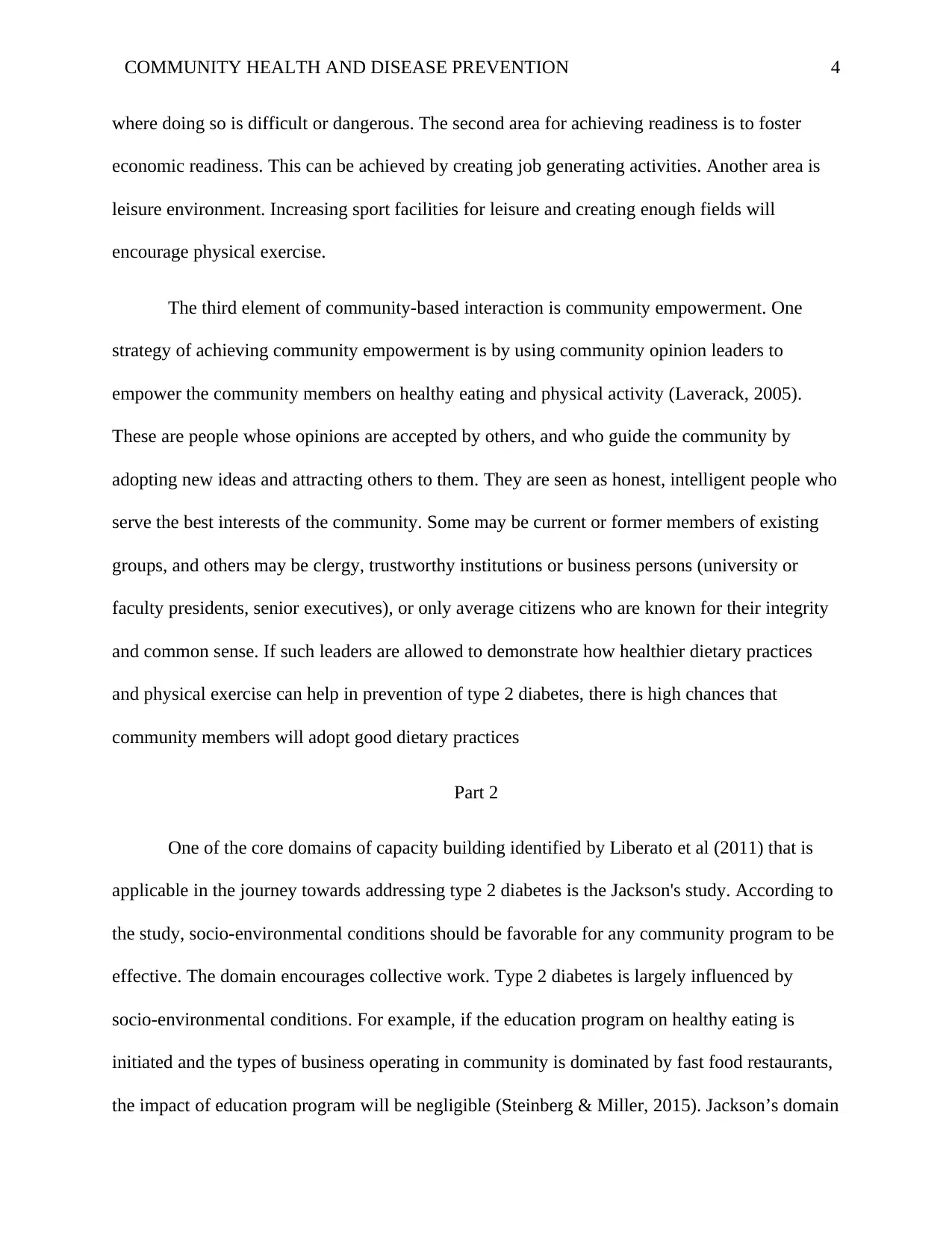
COMMUNITY HEALTH AND DISEASE PREVENTION 4
where doing so is difficult or dangerous. The second area for achieving readiness is to foster
economic readiness. This can be achieved by creating job generating activities. Another area is
leisure environment. Increasing sport facilities for leisure and creating enough fields will
encourage physical exercise.
The third element of community-based interaction is community empowerment. One
strategy of achieving community empowerment is by using community opinion leaders to
empower the community members on healthy eating and physical activity (Laverack, 2005).
These are people whose opinions are accepted by others, and who guide the community by
adopting new ideas and attracting others to them. They are seen as honest, intelligent people who
serve the best interests of the community. Some may be current or former members of existing
groups, and others may be clergy, trustworthy institutions or business persons (university or
faculty presidents, senior executives), or only average citizens who are known for their integrity
and common sense. If such leaders are allowed to demonstrate how healthier dietary practices
and physical exercise can help in prevention of type 2 diabetes, there is high chances that
community members will adopt good dietary practices
Part 2
One of the core domains of capacity building identified by Liberato et al (2011) that is
applicable in the journey towards addressing type 2 diabetes is the Jackson's study. According to
the study, socio-environmental conditions should be favorable for any community program to be
effective. The domain encourages collective work. Type 2 diabetes is largely influenced by
socio-environmental conditions. For example, if the education program on healthy eating is
initiated and the types of business operating in community is dominated by fast food restaurants,
the impact of education program will be negligible (Steinberg & Miller, 2015). Jackson’s domain
where doing so is difficult or dangerous. The second area for achieving readiness is to foster
economic readiness. This can be achieved by creating job generating activities. Another area is
leisure environment. Increasing sport facilities for leisure and creating enough fields will
encourage physical exercise.
The third element of community-based interaction is community empowerment. One
strategy of achieving community empowerment is by using community opinion leaders to
empower the community members on healthy eating and physical activity (Laverack, 2005).
These are people whose opinions are accepted by others, and who guide the community by
adopting new ideas and attracting others to them. They are seen as honest, intelligent people who
serve the best interests of the community. Some may be current or former members of existing
groups, and others may be clergy, trustworthy institutions or business persons (university or
faculty presidents, senior executives), or only average citizens who are known for their integrity
and common sense. If such leaders are allowed to demonstrate how healthier dietary practices
and physical exercise can help in prevention of type 2 diabetes, there is high chances that
community members will adopt good dietary practices
Part 2
One of the core domains of capacity building identified by Liberato et al (2011) that is
applicable in the journey towards addressing type 2 diabetes is the Jackson's study. According to
the study, socio-environmental conditions should be favorable for any community program to be
effective. The domain encourages collective work. Type 2 diabetes is largely influenced by
socio-environmental conditions. For example, if the education program on healthy eating is
initiated and the types of business operating in community is dominated by fast food restaurants,
the impact of education program will be negligible (Steinberg & Miller, 2015). Jackson’s domain
Paraphrase This Document
Need a fresh take? Get an instant paraphrase of this document with our AI Paraphraser
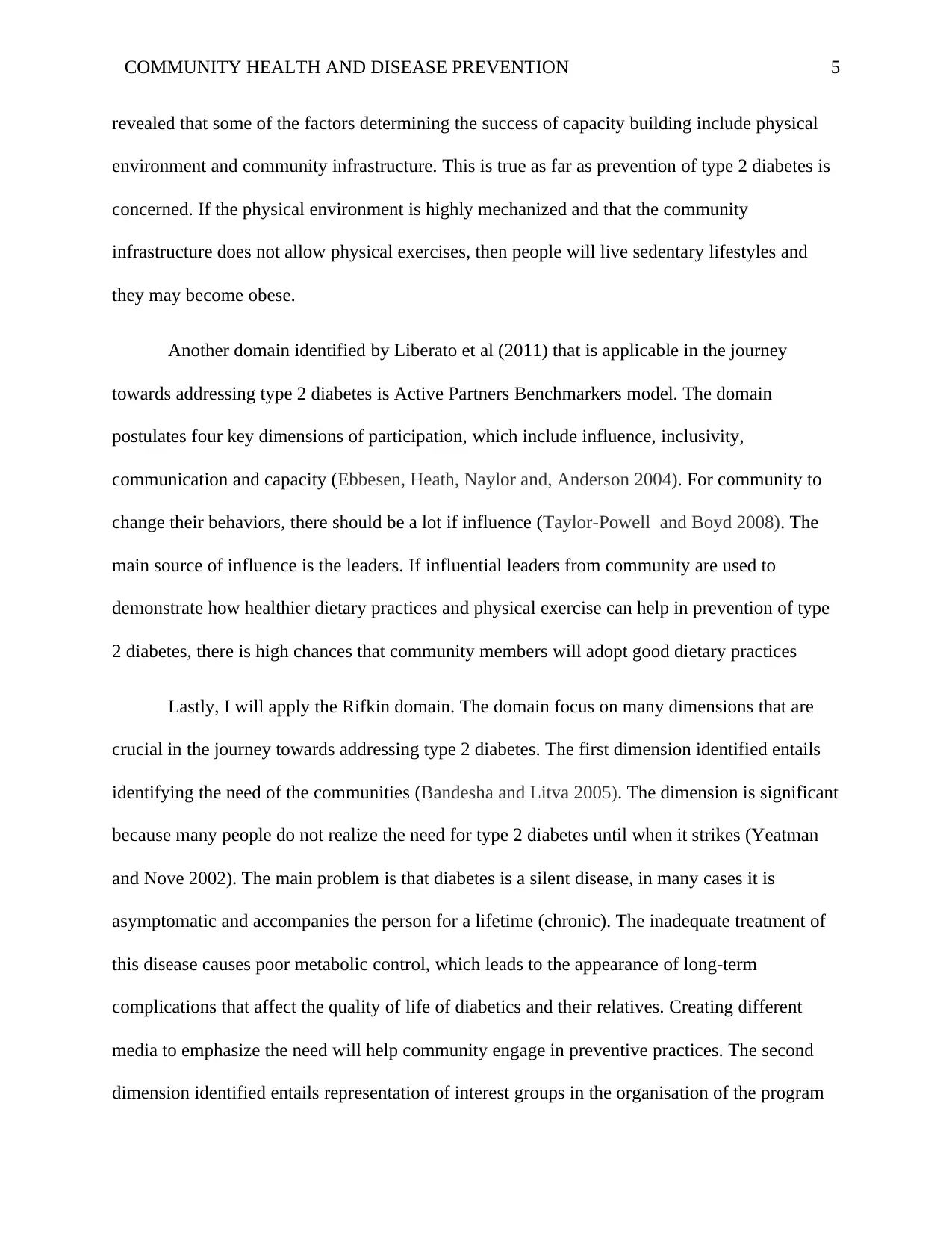
COMMUNITY HEALTH AND DISEASE PREVENTION 5
revealed that some of the factors determining the success of capacity building include physical
environment and community infrastructure. This is true as far as prevention of type 2 diabetes is
concerned. If the physical environment is highly mechanized and that the community
infrastructure does not allow physical exercises, then people will live sedentary lifestyles and
they may become obese.
Another domain identified by Liberato et al (2011) that is applicable in the journey
towards addressing type 2 diabetes is Active Partners Benchmarkers model. The domain
postulates four key dimensions of participation, which include influence, inclusivity,
communication and capacity (Ebbesen, Heath, Naylor and, Anderson 2004). For community to
change their behaviors, there should be a lot if influence (Taylor-Powell and Boyd 2008). The
main source of influence is the leaders. If influential leaders from community are used to
demonstrate how healthier dietary practices and physical exercise can help in prevention of type
2 diabetes, there is high chances that community members will adopt good dietary practices
Lastly, I will apply the Rifkin domain. The domain focus on many dimensions that are
crucial in the journey towards addressing type 2 diabetes. The first dimension identified entails
identifying the need of the communities (Bandesha and Litva 2005). The dimension is significant
because many people do not realize the need for type 2 diabetes until when it strikes (Yeatman
and Nove 2002). The main problem is that diabetes is a silent disease, in many cases it is
asymptomatic and accompanies the person for a lifetime (chronic). The inadequate treatment of
this disease causes poor metabolic control, which leads to the appearance of long-term
complications that affect the quality of life of diabetics and their relatives. Creating different
media to emphasize the need will help community engage in preventive practices. The second
dimension identified entails representation of interest groups in the organisation of the program
revealed that some of the factors determining the success of capacity building include physical
environment and community infrastructure. This is true as far as prevention of type 2 diabetes is
concerned. If the physical environment is highly mechanized and that the community
infrastructure does not allow physical exercises, then people will live sedentary lifestyles and
they may become obese.
Another domain identified by Liberato et al (2011) that is applicable in the journey
towards addressing type 2 diabetes is Active Partners Benchmarkers model. The domain
postulates four key dimensions of participation, which include influence, inclusivity,
communication and capacity (Ebbesen, Heath, Naylor and, Anderson 2004). For community to
change their behaviors, there should be a lot if influence (Taylor-Powell and Boyd 2008). The
main source of influence is the leaders. If influential leaders from community are used to
demonstrate how healthier dietary practices and physical exercise can help in prevention of type
2 diabetes, there is high chances that community members will adopt good dietary practices
Lastly, I will apply the Rifkin domain. The domain focus on many dimensions that are
crucial in the journey towards addressing type 2 diabetes. The first dimension identified entails
identifying the need of the communities (Bandesha and Litva 2005). The dimension is significant
because many people do not realize the need for type 2 diabetes until when it strikes (Yeatman
and Nove 2002). The main problem is that diabetes is a silent disease, in many cases it is
asymptomatic and accompanies the person for a lifetime (chronic). The inadequate treatment of
this disease causes poor metabolic control, which leads to the appearance of long-term
complications that affect the quality of life of diabetics and their relatives. Creating different
media to emphasize the need will help community engage in preventive practices. The second
dimension identified entails representation of interest groups in the organisation of the program
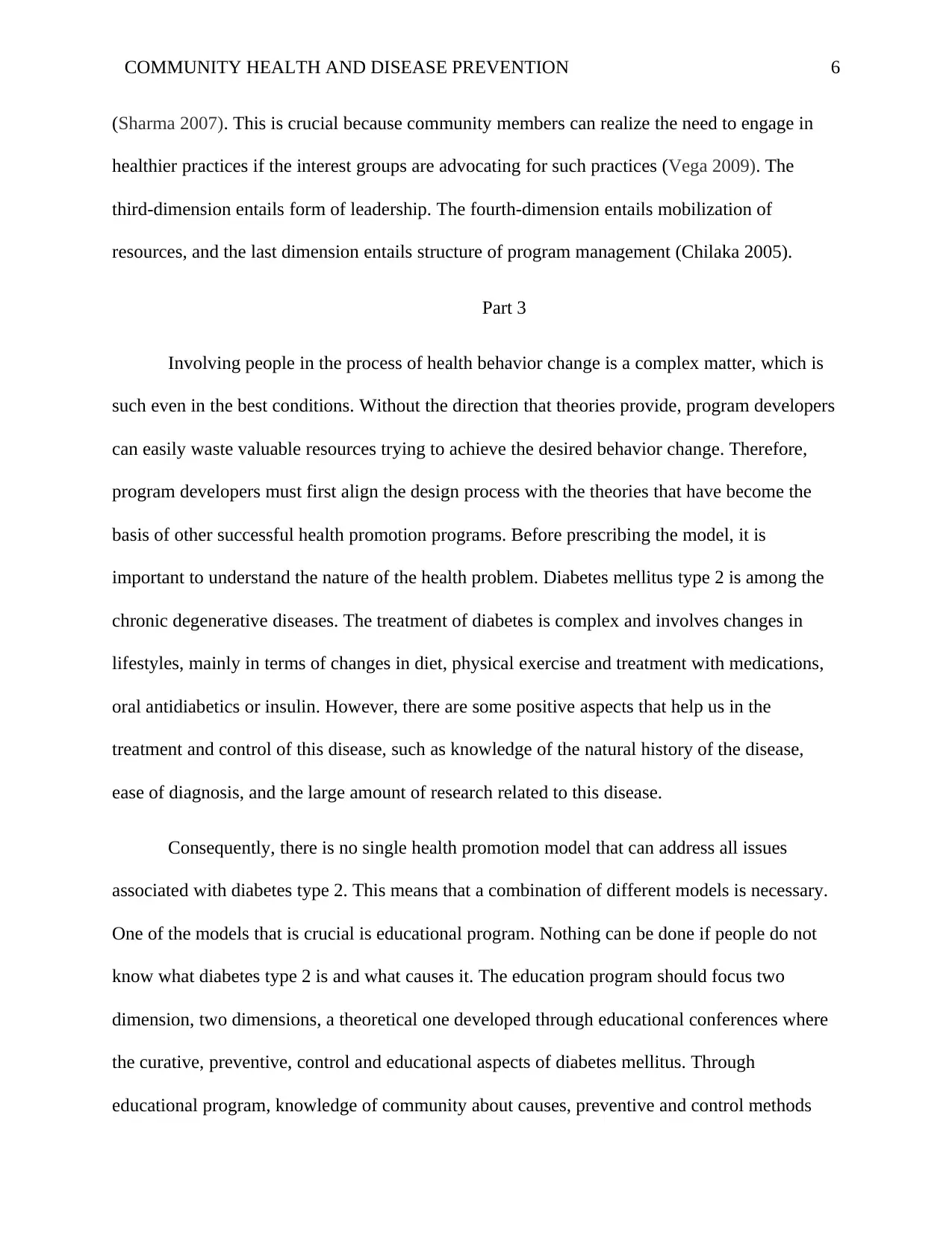
COMMUNITY HEALTH AND DISEASE PREVENTION 6
(Sharma 2007). This is crucial because community members can realize the need to engage in
healthier practices if the interest groups are advocating for such practices (Vega 2009). The
third-dimension entails form of leadership. The fourth-dimension entails mobilization of
resources, and the last dimension entails structure of program management (Chilaka 2005).
Part 3
Involving people in the process of health behavior change is a complex matter, which is
such even in the best conditions. Without the direction that theories provide, program developers
can easily waste valuable resources trying to achieve the desired behavior change. Therefore,
program developers must first align the design process with the theories that have become the
basis of other successful health promotion programs. Before prescribing the model, it is
important to understand the nature of the health problem. Diabetes mellitus type 2 is among the
chronic degenerative diseases. The treatment of diabetes is complex and involves changes in
lifestyles, mainly in terms of changes in diet, physical exercise and treatment with medications,
oral antidiabetics or insulin. However, there are some positive aspects that help us in the
treatment and control of this disease, such as knowledge of the natural history of the disease,
ease of diagnosis, and the large amount of research related to this disease.
Consequently, there is no single health promotion model that can address all issues
associated with diabetes type 2. This means that a combination of different models is necessary.
One of the models that is crucial is educational program. Nothing can be done if people do not
know what diabetes type 2 is and what causes it. The education program should focus two
dimension, two dimensions, a theoretical one developed through educational conferences where
the curative, preventive, control and educational aspects of diabetes mellitus. Through
educational program, knowledge of community about causes, preventive and control methods
(Sharma 2007). This is crucial because community members can realize the need to engage in
healthier practices if the interest groups are advocating for such practices (Vega 2009). The
third-dimension entails form of leadership. The fourth-dimension entails mobilization of
resources, and the last dimension entails structure of program management (Chilaka 2005).
Part 3
Involving people in the process of health behavior change is a complex matter, which is
such even in the best conditions. Without the direction that theories provide, program developers
can easily waste valuable resources trying to achieve the desired behavior change. Therefore,
program developers must first align the design process with the theories that have become the
basis of other successful health promotion programs. Before prescribing the model, it is
important to understand the nature of the health problem. Diabetes mellitus type 2 is among the
chronic degenerative diseases. The treatment of diabetes is complex and involves changes in
lifestyles, mainly in terms of changes in diet, physical exercise and treatment with medications,
oral antidiabetics or insulin. However, there are some positive aspects that help us in the
treatment and control of this disease, such as knowledge of the natural history of the disease,
ease of diagnosis, and the large amount of research related to this disease.
Consequently, there is no single health promotion model that can address all issues
associated with diabetes type 2. This means that a combination of different models is necessary.
One of the models that is crucial is educational program. Nothing can be done if people do not
know what diabetes type 2 is and what causes it. The education program should focus two
dimension, two dimensions, a theoretical one developed through educational conferences where
the curative, preventive, control and educational aspects of diabetes mellitus. Through
educational program, knowledge of community about causes, preventive and control methods
⊘ This is a preview!⊘
Do you want full access?
Subscribe today to unlock all pages.

Trusted by 1+ million students worldwide
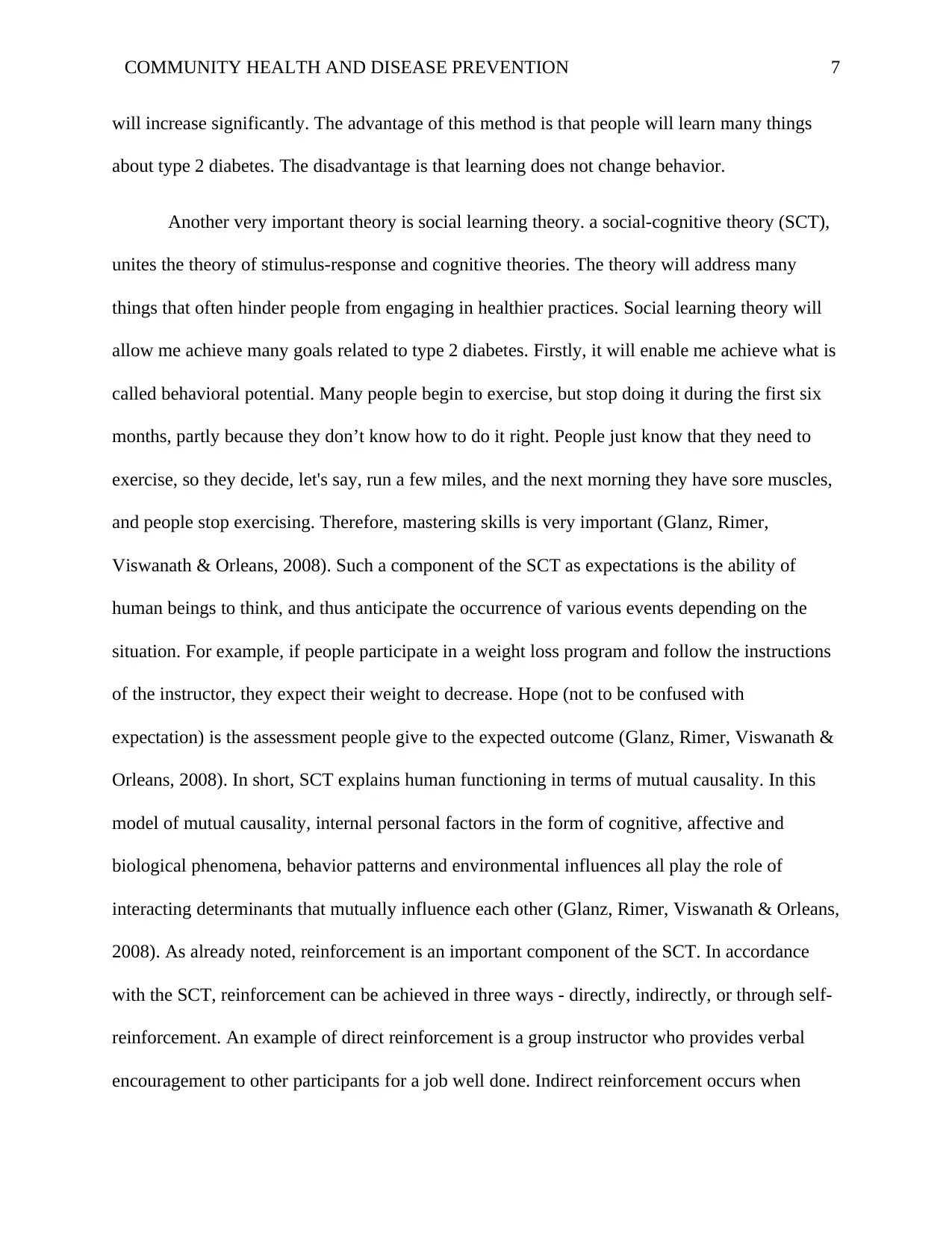
COMMUNITY HEALTH AND DISEASE PREVENTION 7
will increase significantly. The advantage of this method is that people will learn many things
about type 2 diabetes. The disadvantage is that learning does not change behavior.
Another very important theory is social learning theory. a social-cognitive theory (SCT),
unites the theory of stimulus-response and cognitive theories. The theory will address many
things that often hinder people from engaging in healthier practices. Social learning theory will
allow me achieve many goals related to type 2 diabetes. Firstly, it will enable me achieve what is
called behavioral potential. Many people begin to exercise, but stop doing it during the first six
months, partly because they don’t know how to do it right. People just know that they need to
exercise, so they decide, let's say, run a few miles, and the next morning they have sore muscles,
and people stop exercising. Therefore, mastering skills is very important (Glanz, Rimer,
Viswanath & Orleans, 2008). Such a component of the SCT as expectations is the ability of
human beings to think, and thus anticipate the occurrence of various events depending on the
situation. For example, if people participate in a weight loss program and follow the instructions
of the instructor, they expect their weight to decrease. Hope (not to be confused with
expectation) is the assessment people give to the expected outcome (Glanz, Rimer, Viswanath &
Orleans, 2008). In short, SCT explains human functioning in terms of mutual causality. In this
model of mutual causality, internal personal factors in the form of cognitive, affective and
biological phenomena, behavior patterns and environmental influences all play the role of
interacting determinants that mutually influence each other (Glanz, Rimer, Viswanath & Orleans,
2008). As already noted, reinforcement is an important component of the SCT. In accordance
with the SCT, reinforcement can be achieved in three ways - directly, indirectly, or through self-
reinforcement. An example of direct reinforcement is a group instructor who provides verbal
encouragement to other participants for a job well done. Indirect reinforcement occurs when
will increase significantly. The advantage of this method is that people will learn many things
about type 2 diabetes. The disadvantage is that learning does not change behavior.
Another very important theory is social learning theory. a social-cognitive theory (SCT),
unites the theory of stimulus-response and cognitive theories. The theory will address many
things that often hinder people from engaging in healthier practices. Social learning theory will
allow me achieve many goals related to type 2 diabetes. Firstly, it will enable me achieve what is
called behavioral potential. Many people begin to exercise, but stop doing it during the first six
months, partly because they don’t know how to do it right. People just know that they need to
exercise, so they decide, let's say, run a few miles, and the next morning they have sore muscles,
and people stop exercising. Therefore, mastering skills is very important (Glanz, Rimer,
Viswanath & Orleans, 2008). Such a component of the SCT as expectations is the ability of
human beings to think, and thus anticipate the occurrence of various events depending on the
situation. For example, if people participate in a weight loss program and follow the instructions
of the instructor, they expect their weight to decrease. Hope (not to be confused with
expectation) is the assessment people give to the expected outcome (Glanz, Rimer, Viswanath &
Orleans, 2008). In short, SCT explains human functioning in terms of mutual causality. In this
model of mutual causality, internal personal factors in the form of cognitive, affective and
biological phenomena, behavior patterns and environmental influences all play the role of
interacting determinants that mutually influence each other (Glanz, Rimer, Viswanath & Orleans,
2008). As already noted, reinforcement is an important component of the SCT. In accordance
with the SCT, reinforcement can be achieved in three ways - directly, indirectly, or through self-
reinforcement. An example of direct reinforcement is a group instructor who provides verbal
encouragement to other participants for a job well done. Indirect reinforcement occurs when
Paraphrase This Document
Need a fresh take? Get an instant paraphrase of this document with our AI Paraphraser
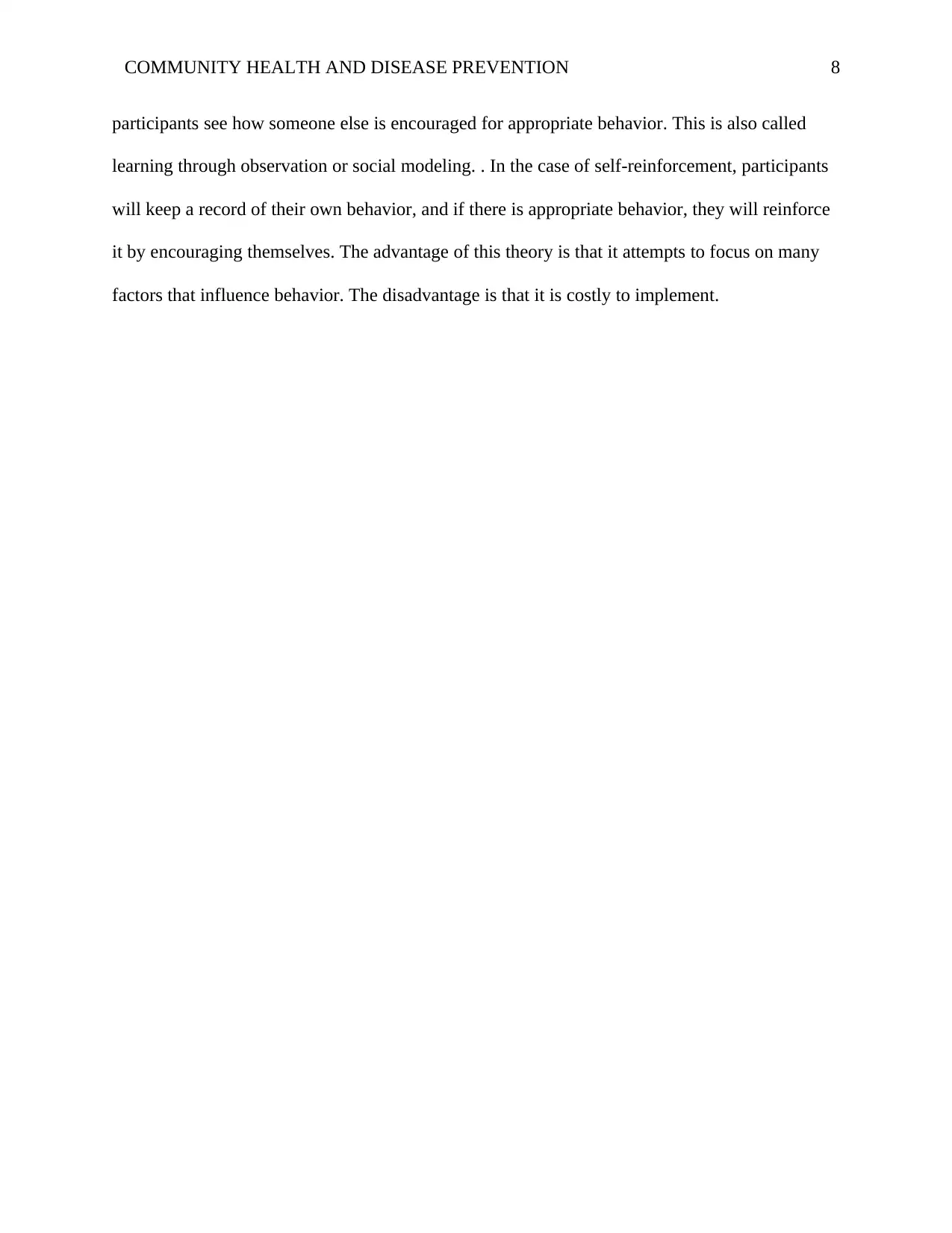
COMMUNITY HEALTH AND DISEASE PREVENTION 8
participants see how someone else is encouraged for appropriate behavior. This is also called
learning through observation or social modeling. . In the case of self-reinforcement, participants
will keep a record of their own behavior, and if there is appropriate behavior, they will reinforce
it by encouraging themselves. The advantage of this theory is that it attempts to focus on many
factors that influence behavior. The disadvantage is that it is costly to implement.
participants see how someone else is encouraged for appropriate behavior. This is also called
learning through observation or social modeling. . In the case of self-reinforcement, participants
will keep a record of their own behavior, and if there is appropriate behavior, they will reinforce
it by encouraging themselves. The advantage of this theory is that it attempts to focus on many
factors that influence behavior. The disadvantage is that it is costly to implement.
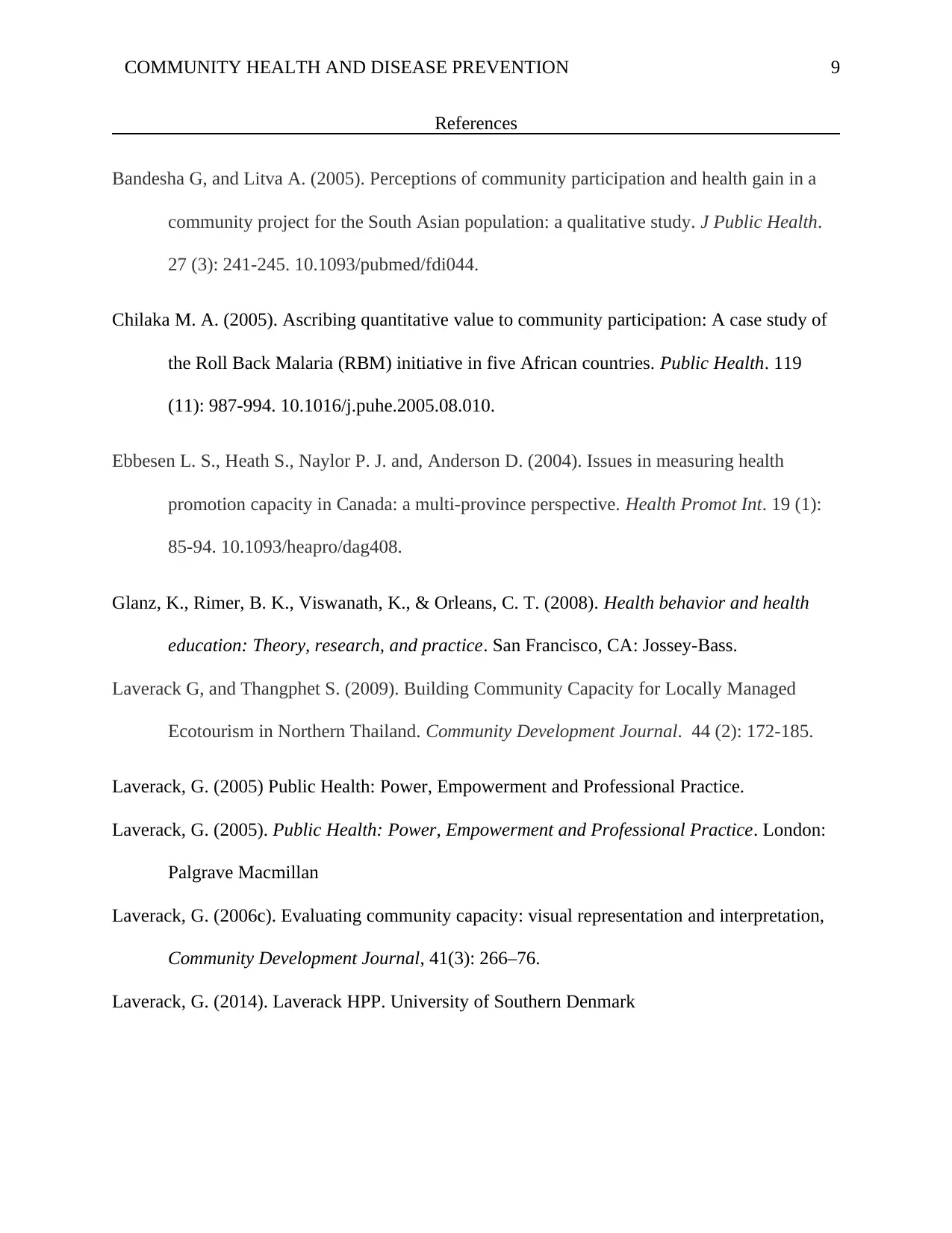
COMMUNITY HEALTH AND DISEASE PREVENTION 9
References
Bandesha G, and Litva A. (2005). Perceptions of community participation and health gain in a
community project for the South Asian population: a qualitative study. J Public Health.
27 (3): 241-245. 10.1093/pubmed/fdi044.
Chilaka M. A. (2005). Ascribing quantitative value to community participation: A case study of
the Roll Back Malaria (RBM) initiative in five African countries. Public Health. 119
(11): 987-994. 10.1016/j.puhe.2005.08.010.
Ebbesen L. S., Heath S., Naylor P. J. and, Anderson D. (2004). Issues in measuring health
promotion capacity in Canada: a multi-province perspective. Health Promot Int. 19 (1):
85-94. 10.1093/heapro/dag408.
Glanz, K., Rimer, B. K., Viswanath, K., & Orleans, C. T. (2008). Health behavior and health
education: Theory, research, and practice. San Francisco, CA: Jossey-Bass.
Laverack G, and Thangphet S. (2009). Building Community Capacity for Locally Managed
Ecotourism in Northern Thailand. Community Development Journal. 44 (2): 172-185.
Laverack, G. (2005) Public Health: Power, Empowerment and Professional Practice.
Laverack, G. (2005). Public Health: Power, Empowerment and Professional Practice. London:
Palgrave Macmillan
Laverack, G. (2006c). Evaluating community capacity: visual representation and interpretation,
Community Development Journal, 41(3): 266–76.
Laverack, G. (2014). Laverack HPP. University of Southern Denmark
References
Bandesha G, and Litva A. (2005). Perceptions of community participation and health gain in a
community project for the South Asian population: a qualitative study. J Public Health.
27 (3): 241-245. 10.1093/pubmed/fdi044.
Chilaka M. A. (2005). Ascribing quantitative value to community participation: A case study of
the Roll Back Malaria (RBM) initiative in five African countries. Public Health. 119
(11): 987-994. 10.1016/j.puhe.2005.08.010.
Ebbesen L. S., Heath S., Naylor P. J. and, Anderson D. (2004). Issues in measuring health
promotion capacity in Canada: a multi-province perspective. Health Promot Int. 19 (1):
85-94. 10.1093/heapro/dag408.
Glanz, K., Rimer, B. K., Viswanath, K., & Orleans, C. T. (2008). Health behavior and health
education: Theory, research, and practice. San Francisco, CA: Jossey-Bass.
Laverack G, and Thangphet S. (2009). Building Community Capacity for Locally Managed
Ecotourism in Northern Thailand. Community Development Journal. 44 (2): 172-185.
Laverack, G. (2005) Public Health: Power, Empowerment and Professional Practice.
Laverack, G. (2005). Public Health: Power, Empowerment and Professional Practice. London:
Palgrave Macmillan
Laverack, G. (2006c). Evaluating community capacity: visual representation and interpretation,
Community Development Journal, 41(3): 266–76.
Laverack, G. (2014). Laverack HPP. University of Southern Denmark
⊘ This is a preview!⊘
Do you want full access?
Subscribe today to unlock all pages.

Trusted by 1+ million students worldwide
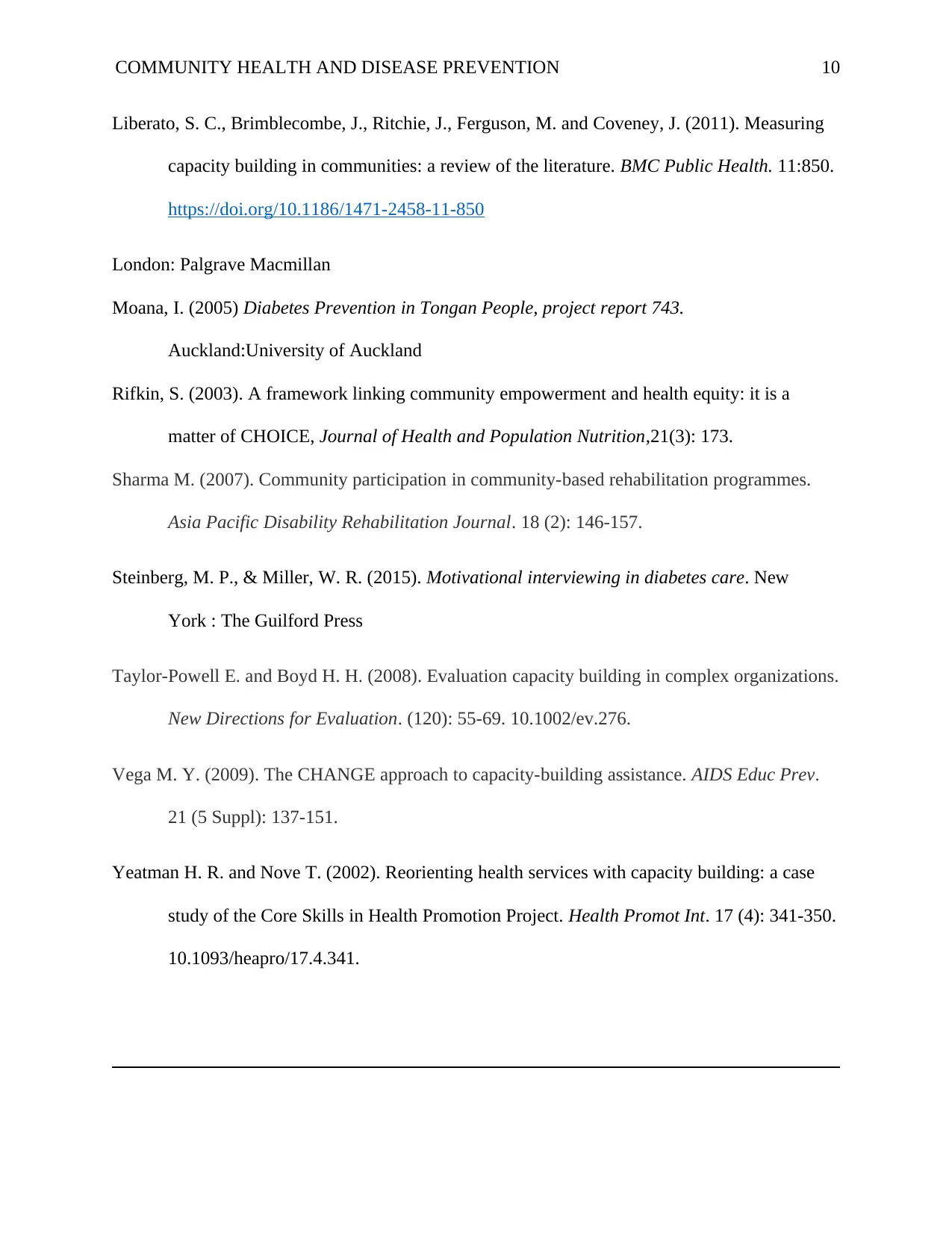
COMMUNITY HEALTH AND DISEASE PREVENTION 10
Liberato, S. C., Brimblecombe, J., Ritchie, J., Ferguson, M. and Coveney, J. (2011). Measuring
capacity building in communities: a review of the literature. BMC Public Health. 11:850.
https://doi.org/10.1186/1471-2458-11-850
London: Palgrave Macmillan
Moana, I. (2005) Diabetes Prevention in Tongan People, project report 743.
Auckland:University of Auckland
Rifkin, S. (2003). A framework linking community empowerment and health equity: it is a
matter of CHOICE, Journal of Health and Population Nutrition,21(3): 173.
Sharma M. (2007). Community participation in community-based rehabilitation programmes.
Asia Pacific Disability Rehabilitation Journal. 18 (2): 146-157.
Steinberg, M. P., & Miller, W. R. (2015). Motivational interviewing in diabetes care. New
York : The Guilford Press
Taylor-Powell E. and Boyd H. H. (2008). Evaluation capacity building in complex organizations.
New Directions for Evaluation. (120): 55-69. 10.1002/ev.276.
Vega M. Y. (2009). The CHANGE approach to capacity-building assistance. AIDS Educ Prev.
21 (5 Suppl): 137-151.
Yeatman H. R. and Nove T. (2002). Reorienting health services with capacity building: a case
study of the Core Skills in Health Promotion Project. Health Promot Int. 17 (4): 341-350.
10.1093/heapro/17.4.341.
Liberato, S. C., Brimblecombe, J., Ritchie, J., Ferguson, M. and Coveney, J. (2011). Measuring
capacity building in communities: a review of the literature. BMC Public Health. 11:850.
https://doi.org/10.1186/1471-2458-11-850
London: Palgrave Macmillan
Moana, I. (2005) Diabetes Prevention in Tongan People, project report 743.
Auckland:University of Auckland
Rifkin, S. (2003). A framework linking community empowerment and health equity: it is a
matter of CHOICE, Journal of Health and Population Nutrition,21(3): 173.
Sharma M. (2007). Community participation in community-based rehabilitation programmes.
Asia Pacific Disability Rehabilitation Journal. 18 (2): 146-157.
Steinberg, M. P., & Miller, W. R. (2015). Motivational interviewing in diabetes care. New
York : The Guilford Press
Taylor-Powell E. and Boyd H. H. (2008). Evaluation capacity building in complex organizations.
New Directions for Evaluation. (120): 55-69. 10.1002/ev.276.
Vega M. Y. (2009). The CHANGE approach to capacity-building assistance. AIDS Educ Prev.
21 (5 Suppl): 137-151.
Yeatman H. R. and Nove T. (2002). Reorienting health services with capacity building: a case
study of the Core Skills in Health Promotion Project. Health Promot Int. 17 (4): 341-350.
10.1093/heapro/17.4.341.
Paraphrase This Document
Need a fresh take? Get an instant paraphrase of this document with our AI Paraphraser

COMMUNITY HEALTH AND DISEASE PREVENTION 11
1 out of 11
Related Documents
Your All-in-One AI-Powered Toolkit for Academic Success.
+13062052269
info@desklib.com
Available 24*7 on WhatsApp / Email
![[object Object]](/_next/static/media/star-bottom.7253800d.svg)
Unlock your academic potential
Copyright © 2020–2025 A2Z Services. All Rights Reserved. Developed and managed by ZUCOL.




